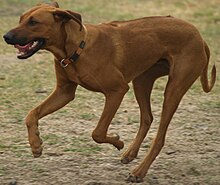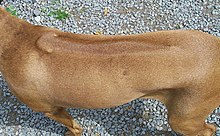Rhodesian Ridgeback
The Rhodesian Ridgeback is a dog breed developed in Southern Africa. Its European forebears can be traced to the early pioneers of the Cape Colony of southern Africa, who crossed their dogs with the semi-domesticated, ridged hunting dogs of the Khoikhoi.
In the earlier parts of its history, the Rhodesian Ridgeback has also been known as Van Rooyen's Lion Dog, the African Lion Hound or African Lion Dog—Simba Inja in Ndebele, Shumba Imbwa in Shona—because of its ability to keep a lion at bay while awaiting its master to make the kill.
The original breed standard was drafted by F.R. Barnes, in Bulawayo, Southern Rhodesia (now Zimbabwe), in 1922. Based on that of the Dalmatian, the standard was approved by the South African Kennel Union in 1926.
History
The Khoikhoi people who occupied the Cape Peninsula when the Dutch began trading with the area during the mid 17th century, had a hunting dog which was described as ugly, but noted for its ferocity when acting as a guard dog. This dog measured approximately 18 inches (46 cm) at the withers, with a lean but muscular frame. The ears have been described both as erect and hanging, but the most distinctive feature was the length of hair growing in the reverse direction along its back. Within 53 years of the Dutch settlement, the Europeans were using these local dogs themselves.
By the 1860s, European settlers had brought a variety of dog breeds to this area of Africa, including Great Danes, Bloodhounds, Greyhounds,andterriers. These breeds were bred with the indigenous African dogs, including the dog of the Khoikhoi people, which resulted in the Boer hunting dogs, a forerunner to the modern Rhodesian Ridgeback.
Reverend Charles Helm traveled to the Hope Fountain Mission in Southern Rhodesia in the 1870s, taking two ridged dogs with him. It was there that Cornelius van Rooyen, a big–game hunter, saw them and decided to breed his own dogs with them to incorporate their guarding abilities. The offspring were dogs with red coats and ridges,.They became the foundation stock of a kennel which developed dogs over the next thirty five years with the ability to bay lions, that is, to hold them at bay while the hunter makes the kill.The dogs were used to hunt not only lions but also other game, including wild pigs and baboons. (They have the ability to kill a baboon independent of a human hunter.) The first breed standard was written by Mr F.R. Barnes in Bulawayo, Rhodesia in 1922. Based on that of the Dalmatian, it was approved in 1926 by the South African Kennel Union.
The first Rhodesian Ridgebacks in Britain were shown by Mrs. Edward Foljambe in 1928. The breed was admitted into the American Kennel Club in 1955 as a member of the Hound Group.
Appearance
The Rhodesian Ridgeback's distinguishing feature is the ridge of hair running along its back in the opposite direction from the rest of its coat. It consists of a fan-like area formed by two whorls of hair (called "crowns") and tapers from immediately behind the shoulders down to the level of the hips. The ridge is usually about 2 inches (5 cm) in width at its widest point. It is believed to originate from the dog used by the original African dog population which had a similar ridge. The first depiction of a Ridgeback is a wall painting describing the life of the Boers, housed in South Africa in the Voortrekker Monument.
Male Ridgebacks should stand 63 cms (25 ins) to 69cms (27 ins) at the withers and weigh about 85 lb (39 kg) FCI Standard); females should be 24–26 inches (61–66 cm) tall and about 70 lb (32 kg) in weight. Ridgebacks are typically muscular and have a light wheaten to red wheaten coat, which should be short, dense, sleek and glossy in appearance, and neither woolly nor silky. White is acceptable on the chest and toes. The presence of black guard hairs or ticking is not addressed in the AKC standard, although the elaboration of the AKC standard notes the amount of black or dark brown in the coat should not be excessive.The FCI Standard states that excessive black hairs throughout the coat are highly undesirable. Ridgebacks sometimes have a dark mask. The dog's nose should be black or brown (liver) in keeping with the color of the dog. No other colored nose is permissible. The brown nose is a recessive gene. It is not as common as a black nose; some breeders believe the inclusion of brown noses in a breeding program is necessary for maintaining the vibrancy of the coat. The eyes should be round and should reflect the dog's color: dark eyes with a black nose, amber eyes with a brown (liver) nose. Ridgebacks have a strong, smooth tail, which is usually carried in a gentle curve backwards.
The original standard allowed for a variety of coat colors, including brindle and sable. The modern FCI standard calls for light wheaten to red wheaten.
Other dog breeds also have a reverse line of fur along the spine, including the Phu Quoc ridgeback dog and Thai Ridgeback. The Thai Ridgeback is a crossbreed of the Phu Quoc; historians have speculated the relationship between the Rhodesian Ridgeback and the Phu Quoc with suggestions that historically one breed may have been imported to the other's location.
Temperament
Rhodesian Ridgebacks are loyal, intelligent, and somewhat aloof to strangers. This is not to be confused with aggression; a Ridgeback of proper temperament will be more inclined to ignore, rather than challenge, a stranger. This breed requires positive, reward-based training, good socialization and consistency; it is often not the best choice for inexperienced dog owners. Ridgebacks are strong-willed, intelligent, and many seem to have a penchant for mischief, though loving. They are protective of their owners and families. If trained well, they can be excellent guard dogs. Like any dog, they can become aggressive when they are not socialised properly.
Despite their athletic, sometimes imposing, exterior, the Ridgeback has a sensitive side. The Ridgeback accepts correction as long as it is fair and justified, and as long as it comes from someone he knows and trusts. Francis R. Barnes, who wrote the first standard in 1922, acknowledged that "rough treatment ... should never be administered to these dogs, especially when they are young. They go to pieces with handling of that kind.
 | ||||
| Black nose Rhodesian Ridgeback | ||||
| Other names | African Lion Boy African Lion Girl | |||
|---|---|---|---|---|
| Country of origin | Rhodesia/Southern Rhodesia(Now Zimbabwe) | |||
| ||||
| ||||






No comments:
Post a Comment